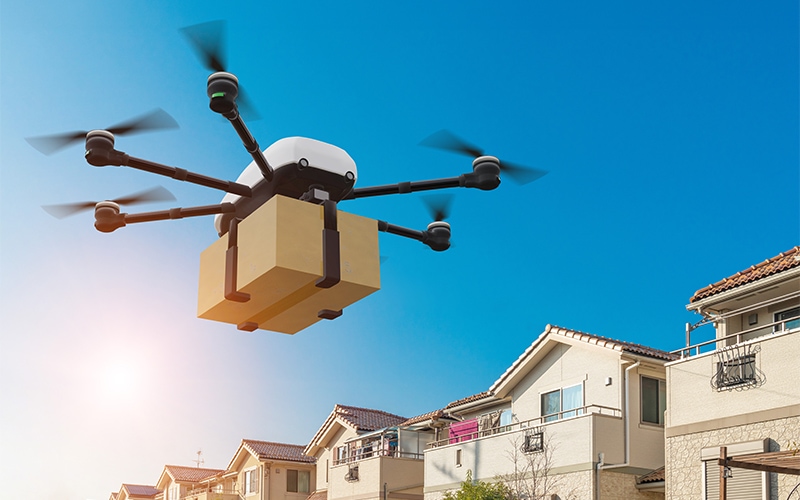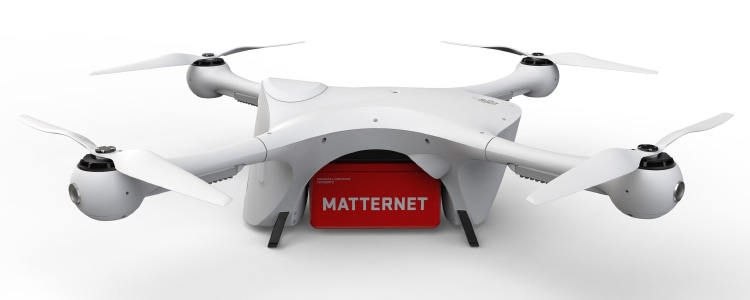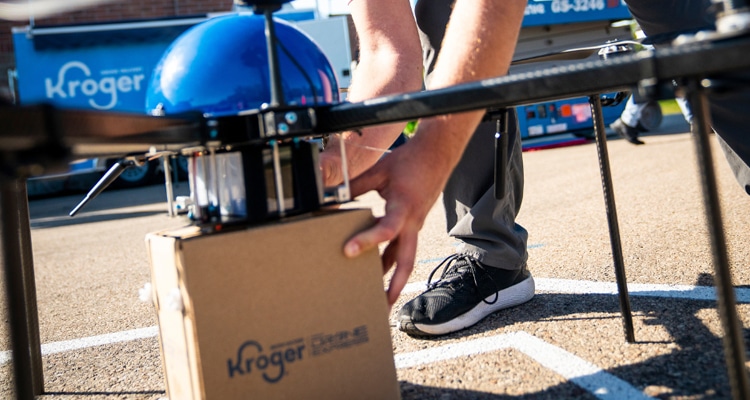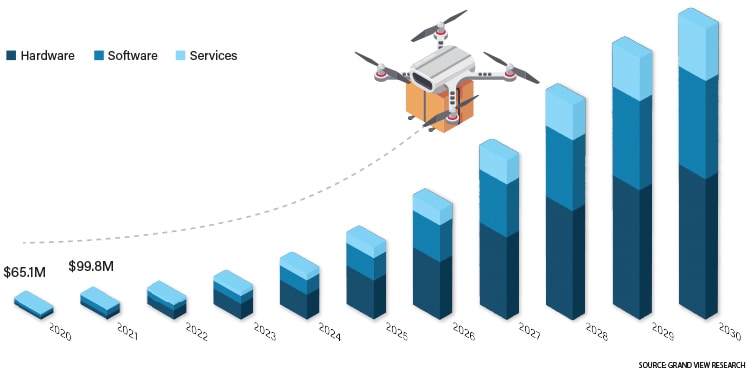From Sky to Doorstep: Drones Deliver the Middle and Last Mile

The United States is in the midst of an aerial revolution, as the soaring potential and advancements in drone technology help reimagine middle and last-mile deliveries.
Despite many hurdles past and present, drones are making inroads—or we might say inflights—in logistics. Although much of the focus centers around last-mile deliveries, companies are turning their attention to drones to deliver the middle mile as well.
Today, drones serve many functions, ranging from monitoring climate change to carrying out search operations after natural disasters to photography, filming, and delivering goods. Amazon first revealed a plan for drone deliveries one decade ago, proclaiming drones would revolutionize shipping methods. At the time the news created quite a stir. Flash forward 10 years and drone delivery does occur, but there are still the hurdles to overcome.
Before a drone can be flown commercially, a user must first procure two certificates: One is an airworthiness certificate for the aircraft itself and the other is a domestic air carrier license, which is necessary to perform any sort of commercial air operations in the United States. Issued by the Federal Aviation Administration (FAA), neither certificate is new or specific to the drone industry, but rather standard procedure for all commercial aircraft.
STRINGENT GUIDELINES HOVER OVER THE INDUSTRY
“Requirement of an airworthiness certificate will make drone delivery as safe as manned aviation,” explains Beth Flippo, chief executive officer of Drone Express, an aviation and last-mile logistics company located in Dayton, Ohio. Acquiring these certificates, however, takes time because even though drones vary greatly from other aircraft, the FAA makes no concessions.
The required domestic air carrier license for drones is the same one required by American Airlines or any other airline. Same goes for the required airworthiness certificate: it’s identical to what a Boeing 747 or any other plane might receive. Not surprisingly, the guidelines are stringent.
“The FAA basically tore our drone apart and had us rebuild it in a way that was considered airworthy. It has to be produced exactly the same each time,” says Flippo, whose company has been working with the FAA for five years trying to get their operating certificates.
Despite that, Drone Express is already deploying drones on last-mile deliveries for their customers, which include Kroger, Winsupply, and Papa Johns Pizza. “In order to fly now, we have to maintain visual line of sight,” Flippo explains.
This means that although their drones fly autonomously, someone has to maintain full control of the aircraft and be prepared to take control should anything adverse occur. It’s a practice Drone Express started in 2021.
“This approach is not sustainable for extended operations,” Flippo notes, but it has allowed her company to start performing deliveries and seeing how the community responds. It’s akin to being in a testing phase and it’s where most drone start-ups are now. The holy grail is to be able to operate beyond line of sight and trust that the aircraft does what it’s supposed to do without connectivity.
PROGRESS TAKES FLIGHT

The Matternet M2 drone can deliver small packages weighing up to about five pounds.
In April 2019, Wing—an initiative of Google’s parent company Alphabet—became the first drone delivery firm to win FAA approval in the United States. The safety evidence it submitted included data that demonstrated a Wing delivery carried “a lower risk to pedestrians than the same trip made by car.”
In August 2023, Wing teamed up with Walmart to deliver items in under 30 minutes to homes located within six miles of stores in the Dallas-Fort Worth area.
Meanwhile in May 2023, drone delivery system developer Matternet’s partner Ameriflight received FAA approval to operate the Matternet M2 drone for commercial delivery, making it the second U.S. operator to obtain such authorization.
Combined, Matternet and Ameriflight became the country’s first fully operational, large-scale drone airline. The airline’s initial intent is to focus on healthcare and ecommerce deliveries.
The relative light weight of lab samples and pharmaceuticals bolsters the healthcare focus. Similar to most drones, a Matternet M2 can carry one package with a maximum weight of 2.2 kilograms or just under five pounds. That isn’t the whole story, however.
“Weight itself was not a key factor in targeting our initial customers,” says Jim O’Sullivan, vice president, regulatory and special projects for Matternet. “We chose to initially focus on hospitals, laboratories, and pharmacies because they rely on ground transport, which can be slow and unreliable. Matternet’s goal is to make critical goods and services accessible to all.”
Certain products do mesh well with last-mile drone delivery. Flippo says she was surprised when Winsupply, a U.S. construction materials distributor, approached them. “At first, I said ‘We can’t deliver a hot water heater by drone. This isn’t a good choice,’” she says.
But after learning that construction sites can shut down over small missing items, the idea made sense. “We can certainly deliver a water faucet and do it quickly so a project’s entire timeline isn’t disrupted,” Flippo says.
ECOMMERCE GETS AIRBORNE

Drone Express provides last-mile drone deliveries for companies including Kroger, Winsupply, and Papa Johns Pizza.
Ecommerce companies and products that are best suited for drone delivery are those that enable ultra-fast delivery of single packages such as food, lightweight consumer goods, and medical prescriptions. Compared to utilizing cars or vans, drone delivery dramatically lowers carbon dioxide emissions.
Integrating drone delivery into an ecommerce setting can take many forms. It can be as simple as hiring an outside drone service provider to operate the drone delivery network and establish a handoff process. “We piggyback off of the buy-online-pickup-in-store model that already exists in many retail settings,” says Flippo. For instance, shoppers order an item online at Target with plans to pick it up in one hour and employees bring it to the front of the store.
“Essentially, we use that same process except our pilots grab the item and put it on the drone for last-mile delivery,” says Flippo. “To employees, it just looks like any other order.”
An ecommerce provider could also bring a drone delivery system in-house and tightly integrate into its workflow. The future will likely see drones sitting on the roofs of stores waiting to launch. It’s conceivable, too, that robots could collect the packages that need to be delivered and bring them to the nearest drone.
Dispatching drone deliveries from a warehouse setting, by contrast, requires a number of landing/takeoff sites set up outside the facility, along with battery charging facilities and drone storage.
“Key challenges to implementing drone delivery for ecommerce include addressing noise issues at the local level as well as establishing scalable methods for sharing airspace with crewed aircraft,” explains O’Sullivan. “Some municipalities have regulations limiting the times and places a drone may land or take off.”
TAKING THE MIDDLE MILE TO NEW HEIGHTS
The vagaries of the regulatory landscape have led some drone startups to concentrate on middle-mile delivery. There’s no need to work out the safety details for landing in someone’s backyard or driveway when larger deliveries to specific cargo drop-off and take-off locations can be accomplished.
That’s the focus of San Francisco-based drone startup Volansi, whose electric-hybrid, vertical takeoff and landing (VTOL), fixed-wing drone is capable of carrying up to 10 pounds of cargo for as far as 50 miles.
Its fixed-wing aspect allows Volansi and other drones like it to fly for longer periods of time, while the vertical takeoff component allows drones to be more nimble and take off from a much wider swath of spaces without needing infrastructure like a runway.
In November 2023, San Francisco-based Elroy Air flew its autonomous hybrid eVTOL cargo aircraft known as the Chaparral for the first time. It took off vertically from the company’s flight test operations center and successfully landed without incident after a 57-second hover flight.
The Chaparral aircraft is designed to carry 300 to 500 pounds of cargo and has a range of up to 300 miles. These kinds of statistics are game changers in the middle-mile arena.
Volansi’s deliveries focus on commercial and defense industries including construction, mining, oil and gas, medical, and heavy equipment operations.
Meanwhile, Elroy Air is working with FedEx Express to test a concept for middle-mile logistics and has also signed several agreements with prospective customers interested in using its Chaparral aircraft for commercial, military, and humanitarian operations.
The bottom line is last-mile delivery drones have smaller payload capacities and shorter ranges than drones being developed for middle-mile logistics. The ability to carry more cargo for longer distances increases middle-mile drone cost benefits over traditional transportation in this area.
Among other advantages, middle-mile drones like Elroy’s slash transportation hours and handoff times tied to trucks and other grounded vehicles. And, they actively shift the economic value of time savings to both the sender and receiver, according to a 2020 white paper from Levitate Capital, a venture firm focused on next-generation air mobility. (Note: Levitate Capital is an Elroy Air investor.)
THE SKY’S THE LIMIT

The global delivery drones market size was valued at $530.2 million in 2022 and is expected to grow at a compound annual growth rate (CAGR) of 42.6% from 2023 to 2030.
A big selling point for last-mile drone delivery is convenience. It’s the ability to get Tylenol to a sick child in the middle of the night within 30 minutes or a forgotten ingredient while cooking dinner.
“We call it the ‘autonomy economy’ and it will change everything,” says Flippo. “It’s not that it’s cheaper per delivery. It’s that you can do incredibly convenient things.” A Drone Express app is already available that allows people to shop locally with unlimited delivery for $9.49 a month.
Early fall 2023 was a busy and productive time in the American drone marketplace. Four drone companies achieved the coveted FAA authorization to fly beyond the visual line of sight (BVLOS).
Two of the companies—Zipline and UPS Flight Forward—intend to use their BVLOS approvals to conduct drone package deliveries. Zipline is authorized to operate its Sparrow drone, while UPS Flight Forward is authorized to operate Matternet 2.
These approvals are a huge step forward for the drone delivery industry, which has been building momentum ever since Jeff Bezos first spun his seemingly fantastical tale regarding the future of Amazon deliveries a decade ago.
It turns out he wasn’t spouting science fiction, as 95% of Amazon deliveries weigh less than five pounds and drone delivery is within the realm of possibility. The company’s Amazon Prime Air service will deliver to customers in three U.S. locations as well as cities in Italy and the UK by the end of 2024.
In terms of last-mile drone delivery, even the five-pound weight limit is surmountable. “If you place a huge order with Kroger, it’ll show up via five drones because it doesn’t cost us anything to send them all to your house,” says Flippo.
Their service also helps customers eliminate the need for order substitutions. “If you order one flavor of ice cream and it’s not in stock, a drone from a different store will bring it to you,” she adds.
A DEMAND FOR EXPERTISE
Drone implementation will also create jobs. Just as manned aviation requires air traffic controllers, so does autonomous aviation. Robotics-related expertise will be in demand, as will software developers working on drone systems. A whole new industry aimed at developing and advancing drones is springing up.
The sky is indeed the limit. “Right now, the regulatory landscape is the biggest hurdle facing mass adoption of drone delivery,” O’Sullivan says. “The innovative technology provides a reliable, eco-friendly, and cost-efficient delivery model.”
